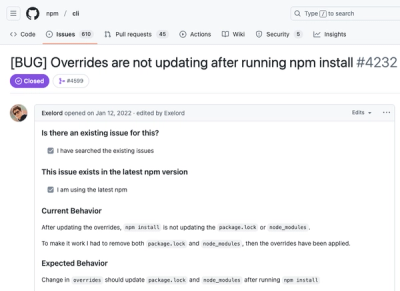named-urls
Simple named url patterns in JavaScript.







Implementing a static route config and named routes on top of (react-router) at this point is like a 20 line ordeal.
– Ryan Florence
Motivation
Named routes are essential to keep route config DRY and prevent silly errors
due to typos. This feature was removed from react-router in 1.0 and I missed
it since then as many
others.
There're other libs dealing with named routes, some of them provide custom
Link, Route routes, some of them have more features to integrate with
express. Here's incomplete list of libs I considered before writing these
20 lines of code (and 200+ lines of other files to publish this package):
NOTE: v2 introduces breaking changes. Please check out the migration guide before upgrading.
Installation
$ npm install named-urls
or
$ yarn add named-urls
Quickstart
Create file with all routes in your application (e.g. routes.js). Use
named-urls/include to create namespaced group of routes with common prefix:
import { include } from 'named-urls'
export default {
profile: '/profile',
article: '/article/:articleId',
messages: '/messages/:messageId?',
auth: include('/auth', {
login: '/login/',
passwordReset: 'password/reset/',
passwordVerify: 'password/verify/',
}),
messages: include('/messages', {
all: '',
unread: 'unread/',
detail: include(':messageId/', {
show: '',
edit: 'edit/',
comments: 'comments/',
})
})
}
Use routes in Route component from react-router-dom:
import React from 'react'
import { Switch, Route } from 'react-router-dom'
import routes from './routes'
import * as scenes from './scenes'
function App() {
return (
<Switch>
<Route path={routes.profile} component={scenes.Profile} />
<Route path={routes.auth.login} component={scenes.auth.Login} />
// ...
<Route path={routes.messages.unread} component={scenes.messages.Unread} />
<Route path={routes.messages.detail.show} component={scenes.messages.Detail} />
</Switch>
)
}
Routes with parameters can be formatted using reverse function:
import React from 'react'
import { Link } from 'react-router'
import { reverse } from 'named-urls'
function Navigation({ messages }) {
return (
<ul>
<li><Link to={`${routes.profile}`}>Profile</Link></li>
// ...
// Use reverse to replace params in route pattern with values
{messages.map(message =>
<li key={message.id}>
<Link to={reverse(`${routes.messages.detail.show}`, { messageId: message.id })}>
Profile
</Link>
</li>
)}
</ul>
)
}
Ending slash
Patterns ending with slash are always reversed to URL with ending slash and vice
versa: Paterns without ending slash are always reserved to URL without endlish
slash:
reverse('pattern/:optional?', { optional: 42 })
reverse('pattern/:optional?')
reverse('pattern/:optional?/', { optional: 42 })
reverse('pattern/:optional?/')
Migrating from v1.x.x to v2.x.x
For better compatibility with React Router, v2 uses path-to-regexp to resolve URLs. This means some of your routes may break when you upgrade.
reverse
-reverse('pattern/page:param?', {})
+reverse('pattern/(page:param)?', {})
reverseForce
-reverseForce('pattern/page:param?', {})
+reverseForce('pattern/(page:param)?', {})
To get a full overview of all accepted patterns, consult the path-to-regexp documentation.
Some tricks
Using an "include" route
If you define a route as an include, calling it directly will return you a function. To by-pass that, you have a solution to create an empty route inside, let's call it self:
import { include } from 'named-urls'
export default {
messages: include('/messages', {
self: '',
detail: include(':messageId/', {
show: '',
edit: 'edit/',
comments: 'comments/',
})
})
}
so you'll be able to do:
<Route path={routes.messages.self} component={Messages} />
A way to not define a useless route is to use the string way of a route like that:
import { include } from 'named-urls'
export default {
messages: include('/messages', {
detail: include(':messageId/', {
edit: 'edit/',
comments: 'comments/',
})
})
}
<Route path={`${routes.messages}`} component={Messages} />
<Route path={String(routes.messages)} component={Messages} />
License
MIT








